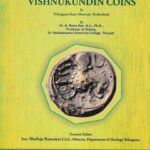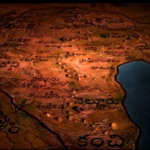Those of you who also read Indic Civilizational Portal would have noticed an article yesterday called “An appeal to Young Indologists”. It was a reprint of a blog Post with a direct account from Pandit Kota Venkatachalam. He was an author of 24 books on history in Telugu and English, many of which can still be found.
Indian History in general, and Andhra history in particular…even very recently, have been subject to many manipulations. The entire chronology, in fact, may be off…by a lot. But Pandit Chelam was not the only voice decrying the propaganda that was being sowed during colonial rule. A number of other Bharatiyas were concerned about what was being done.
One such Telugu was the famous Kavisamrat, Sri Viswanatha Satyanarayana. Needing no introduction to any Andhraite of good taste, he was the author of the celebrated Veyi Padagalu. In a preface to Sri Kota Venkatachalam’s book “The Plot in Indian Chronology”, the Kavisamrat wrote extensively and effusively about the efforts of his contemporary. He too, like the average Indian, hoped to know the truth about our history. Here is what he had to say [Emphasis and Proofing Ours]
The following Post was published at True Indian History on July 3, 2010
§
About fifty years of the life of Sri Kota Venkata Chelam , the author of this book, have been spent in untiring quest after truth, regarding the ancient history of India. He has ransacked the indigenous literature dealing with our history as also the great bulk of the eastern and western books, the writings of the western Indologists, and has refuted the illogical arguments of the western historians, and established the truth of the correctness of the historical data detailed in our Puranas. English education has banished sound scholarship in our ancient lore and also genuine zeal to probe into its secret depths. Now-a-days scholarship means being at home with what is written by the western scholars. The western scholars have discredited the hoary past of our ancient culture and tried their very best to bring down the dates to suit their purpose. A thousand changes they have made in the dates and in the names of the kings. The whole thing is confusion worse confounded.
It requires a Himalayan effort and unquenchable thirst on the part of a real nationalist to lay bare the scheme and the conspiracy that was responsible for throwing dust upon the veracity of the Puranic account. At present it is not possible to know the true history our ancient India. Sound scholarship in Sanskrit and the same in English are generally divorced from each other, and the special merit of this book is that it is based on a critical examination of the original Sanskrit texts and attempts to point out the defects in the Indological literature in English.
A correct approach to the study of Indian history, to start with, is to understand clearly the three great Eras that were in vogue in ancient India. Sir William Jones, and the other historians like Dr. Wilson, General Cunningham, Prof. Max Muller, Dr. Hultzsch, Dr. Buhler and Dr. Stein have all accepted that the Kali Era began in 3102 B.C., on Feb. 20th by 2 Hr. 27’ 30″. Thirty six years before this year the Mahabharata war was waged. That means the Mahabharata war took place in 3138 B.C. . Thirty six years after the beginning of the Kali Era i.e., 3076 B.C. Dharmaraja and his brothers renounced their kingdom and repaired to the land of the gods. That year was the beginning of the Saptarshi Saka or the Loukika Era which continues to be in vogue since that time in Kashmir. These are the three Sakas according to which all calculations in our Puranas and historical records are made. The western historians had known the existence of these three Eras and yet they wrote that no possibilities to ascertain the dates of incidents and kings ever existed in our Puranas. The present author has quoted the very same historians and proved the validity of the dates in the Puranas.
The whole confusion began when the western scholars, rather wilfully ousted Gupta Chandra-Gupta and made Maurya Chandra-Gupta usurp his place. Gupta Chandra- Gupta Flourished in 327 B.C., and was the contemporary of Alexander. Maurya Chandra-Gupta lived in 1534 B.C. But the western historians wrongly identified Alexander’s contemporary with Maurya Chandra-Gupta. This Himalayan blunder upset the whole scheme and brought terrible chaos into our Puranic dates. And now if this little correction is made, every detail in our ancient Puranas is found to be correct. If this correction is not accepted the vast bulk of the Hindu, Jain and Buddhistic literature appears to be a spurious account of facts and dates. One can know from this that the western scholars have found our historical dates incorrect because they have confounded between the Chandraguptas of the Gupta and Mauryan dynasties.
The author of this book has proved to the hilt that this confounding is wilful and Sir William Jones, the first historian of India, has changed this date to effect a sort of similitude between the Biblical and the Hindu conceptions to time. Even Max-Muller, known to be a great lover of Hindu culture, accepted what Jones has written, saying in so many plain words, that he accepted this to bring harmony between the Greek and Hindu Chronology. Twelve centuries of time after the Mahabharata war and ten centuries before that are struck off like this and the history we get now is put upon this wrong base. The whole plot is revealed in this book; and the spurious arguments advanced by the Western historians have been proved here to be the results of prejudicial minds. The author of this book has spared no pains to prove the correctness of the Puranic data. He quotes copiously from Astronomical texts, which in the Puranas are based on the movements of the Great Bear and asserts that it is 5092 years since the Mahabharata war to this day (in 1954; 3102+36+1954=5092) and that it is 2811 years since the Mahabharata war to the end of the Andhra dynasty or the beginning of the Gupta dynasty, and the interval is 1500 years between the Mahabharata war and the coronation of Mahapadmananda, and the period elapsed between the coronation of Mahapadmananda and the beginning of the rule of the Andhras is 836 years. It is proved beyond doubt that the traditional calculations of our ancient sages are correct to the decimal and the history of the Kali yuga kings written in different Puranas is genuine.
In short the author has successfully cleared the doubts that are made to linger in our minds regarding our ancient history and set right the differences that arose because of the western scholars’ wrong conjectures in the histories of Magadha, Kashmir and Nepal. Mihirakula and Toramana are said to be Hunas. They were kshatriya kings. They flourished before the Christian Era. They are said to have lived centuries later. And this is a case where a discrepancy of 1200 years is shown to the discredit of the author of Kashmir history (Kalhana). The western scholars have not only bungled facts and tampered with texts, but they even went to the extent of hurling abuse at our ancient historians and sages. The whole mischief is plainly revealed in this book. This book has thrown light upon many other things. The author has discussed at large the many debatable points in Indian history. After reading the 6th chapter of this book none can contend that the Chandragupta of Megasthenes is the Chandragupta of Kautilya. The chapter is a store house of erudition and a brilliant attack upon his antagonists. The facts marshalled herein are irrefutable.
The seventh chapter discusses Asoka’s edict wherein is proved that the Yona kings are not Greeks of the 3rd century B.C., and the kings who ruled Abhisara, Uraga, Simhapura, Divyakataka and Uttara Jyotisha in the 15th century B.C., are Yavana Kshatriyas and that the present Greece was called Ionia at that time because it was occupied by these Yavana Kshatriyas and that the present Greeks are a mixed race. These new facts are to be studied and noted by one and all.
The 8th chapter is like a treatise upon the science of unearthing, reading and interpreting inscriptions. What mischief could be played in this field is portrayed with illustrations. Where there is no date, a historian with no respect for truth says there is one as is done in the case of Kharavela’s Hati-gumpha inscription. A date was given and it is found in all the text books. This colossal untruth is proved in this chapter.
The 10th chapter is a detailed account of the history of the tampering made in the Aihole inscription. The author gave us the original and showed how the letters of the inscription were changed to suit the date of the modern historians. It was changed from B.C. to A.D. The author basing his arguments even upon this inscription proved that the date of the Mahabharata war is 3138 B.C., and the other era used in the same inscription is the Cyrus Era of 550 B.C. It is the duty of a good historian exactly to find out what era is used in what inscription.
Long before Sri Venkatachelam garu, a great Western scholar Prof. M. Troyer had raised his voice of protest against the modern historians. Many other oriental scholars have written many books disproving the accounts of the western historians. Mr. T. S. Narayana Sastry is one of them, and the present author has borrowed much from him in the ninth chapter of this book to prove by astronomical calculation the date of the Mahabharata war, which took place in 3138 B.C. He has studied our Puranas, and the English books written by the western historians and their Indian followers and spent all his time and much of his money to set right this great wrong done to our nation. But to what extent he will be successful God only knows. Faith is instinctive. It is not a child of conviction and conviction is born of argument. In this sad process self interest is an interlude. God is great. If there will come a day when Indians realise the wrong done to their history, this book will be of very great value.
I am no historian and I am asked to write this preface. Perhaps the author saw in me a zeal akin to his to see the resuscitation of our ancient glory which has suffered much at the hands of the enemies to our culture.
V.Satyanarayana
30-3-54
§
Our sincere thanks to G.D. Prasad garu, who is the grandson of Pandit Chelam, for graciously granting permission to reprint this article, which published sections from Sri Kota Venkatachalam’s work.






